Frankfurt am Main, Germany, October 3rd - 13th 1909
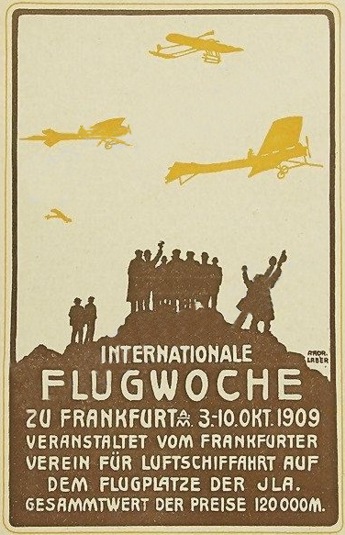


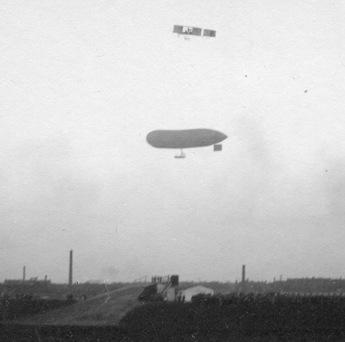
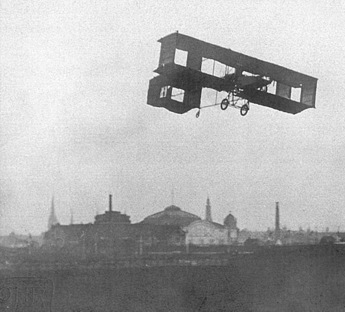
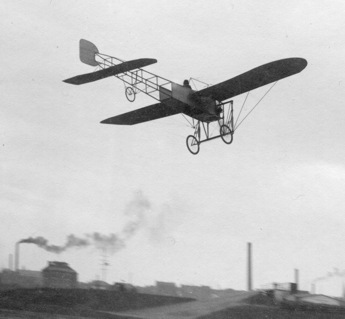

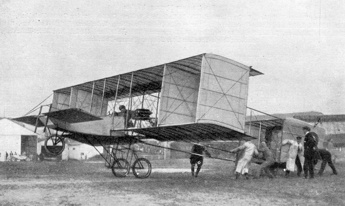

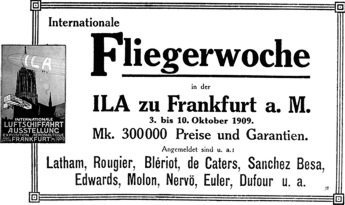
Frankfurt am Main was an important town already a hundred years ago,
with a population of almost 350,000 and a long tradition of trade fairs
and exhibitions. In 1909 it was decided to hold an aeronautical
exhibition, the ILA (Internationale Luftschiffartausstellung) there,
one of the first of its kind. It was open for three months, from July
10th to October 10th. It was mainly focussed on lighter-than-air
flight, but there was also place for other forms of aviation. At the
exhibition fourteen prizes of a total value of 200,000 Mark were given,
for aeroplanes, aeroplane models, dirigibles, dirigible motors,
dirigible hangars, dirigible cars, propellers, free balloons, rubber
balloons, balloon photography, carrier pigeons, light metal,
aeronautical astronomy and cinematographic views of the flight of
birds.
Aeroplanes were mainly represented in the form of models and
photographs, but baron de Caters was contracted to give several
exhibition flights and automobile manufacturers Opel offered a 20,000
Mark prize for the fastest flight between Frankfurt and Rüsselsheim and
back (around 40 km) during the exhibition.
In the beginning of September the organizers of the ILA announced that
an aviation week, modelled on those at Reims and Brescia, would be held
during the last week of the event, on October 3rd to 10th. As usual an
impressive list of potential participants was announced, including
Wilbur Wright and Mario Calderara, but competition from the meetings of
Berlin and Cologne was tough and in the end the final list of
participants contained seven names, some well-known and some
novices:
- Louis Blériot (Blériot)
- Pierre de Caters (Voisin)
- August Euler (Voisin)
- Hubert Latham (Antoinette)
- Alfred Nervø (Voisin)
- Henri Rougier (Voisin)
- Franz Sido (Sido)
Chileans José Luis Sánchez Besa and Emilio Edwards on Voisins had
also entered, but they had wrecked their planes during the Berlin
meeting. Jean Dufour on Farman and Léon Molon on Blériot were also
entered, but didn't turn up. Calderara was there, but didn't
fly. The main event was the 50,000 Mark "Preis der Stadt
Frankfurt" for the non-stop flight of longest endurance, but there
were several other competitive events, including daily speed and
distance prizes on several days. The length of the course was given as
1.667 kilometres, but since the average speeds of the races seem
unrealistically high it was probably shorter. There were also time and
distance contests for gliders.
Sunday October 3rd
On the first day of the event, none of the big names made any efforts.
The first flight was made by the Danish flyer Nervø, who had just
learned to fly in Mourmelon, and the day's flying was shared
between him and the German Euler, who was also learning. The longest
flight was only 1 minute 32 seconds.
Monday October 4th and Tuesday October 5th
These days were apparently not intended as official flying days, but
they were anyway rainy so apart from Latham making a couple of failed
attempts there was no flying.
Wednesday October 6th
There was more action on the fourth day. Nervø and Euler continued
their experiments with better and better results, Nervø eventually
completing a lap, before Euler hit a fence. The German pilot Sido tried
to make the first start in a monoplane of his own construction. He
ended up with the airplane standing on its nose after a take-off roll
of some ten metres and he had to be rescued from this precarious
situation by helpers. Latham made three efforts, but his Antoinette
engine was plagued by mechanical problems and his relatively small
wheels got stuck in the sodden ground, so he could only make a single
flight of one lap. The big star of the day was Rougier, who made three
spectacular flights during the afternoon. On the first flight he flew
four laps before shutting down his engine and gliding down from an
altitude of 60 meters. It first seemed like he might land short and hit
factory buildings outside the airfield, but he managed to make a safe
landing. Half an hour later he was in the air again, this time flying
three laps, reaching altitudes of more than 150 meters. He even flew
above the airship "Parseval", overtaking it, to the ecstatic
ovations of the crowds.
Thursday October 7th
The next day was not as spectacular, but saw continuous improvements of
Euler and Nervø. Euler made a flight of 4:54, reaching a height of ten
meters, hailed as the first flight of any duration by a German made by
a German. Daily speed and distance prizes were awarded for the first
time, with Euler and Rougier sharing the honours. After four more
failed attempts to get airborne, Latham finally gave up and to the
disappointment of the crowd withdrew from the contest and left
Frankfurt. Apart from the mechanical problems, the big and unwieldy
Antoinette was not suited to the small airfield. The short course
required tight turns in which he lost too much altitude.
Friday October 8th
A windy and rainy day. No flying was possible.
Saturday October 9th
Blériot and de Caters were ready to fly on the Saturday. The weather
was still windy and rainy during the morning, but when the wind calmed
down towards the afternoon they wasted no time getting into the air.
Blériot made four flights totalling almost 41 minutes and de Caters
three, totalling 27 minutes. Nervø made an unsuccesful effort
for the slow flight prize. Blériot took both the daily speed and
distance prices, destroying Rougier's previous best with a lap of 1
minute 17 seconds.
Sunday October 10th
This was the day when the main event, the 50,000 Mark "Preis der
Stadt Frankfurt" would be decided. However, there was big drama
not only on the airfield, but also in the courtroom. During the
previous days Rougier had, without permission, used an engine and a
landing gear which belonged to de Caters. These spares had been sent to
de Caters by the Voisin factory on September 28th, during the Berlin
meeting. Rougier had suffered a couple of mishaps during that meeting
and damaged his machine. He was in desperate need of replacements in
order to be able to participate in the Frankfurt meeting, so he
"borrowed" them, without telling de Caters. During the Berlin
meeting de Caters had during some stormy discussions, without success,
requested Rougier to give them back. Since he didn't want to miss
his chance at the Frankfurt prize money de Caters went to a local
court, which sentenced Rougier to two weeks in prison and ordered him
to give the parts back. This also resulted in Rougier being
disqualified from the events in which he had used de Caters' parts.
Blériot was first to try for the City of Frankfurt prize, starting at
around four o'clock, beating the one hour minimum time with a
flight of 60 laps in 72 minutes and 40 seconds. De Caters started soon
before Blériot landed. He made a slower flight of 54 laps in 77
minutes, which won him the prize, since the contest was for endurance,
not distance. When asked for his impression of the flight after
landing, de Caters remarked that "this merry-go-round flying is
quite monotonous". The pilots were strictly forbidden to fly
outside the airfield. Nervø tried for the 5-kilometre speed prize, but
was forced down by strong side winds almost immediately. Blériot
improved his one-lap time to 1 minute 13 seconds, taking the daily
speed prize.
Monday October 11th
The meeting was originally intended to finish on the 10th, on the same
day as the ILA closed, but the Berlin meeting, to the dismay of the
Frankfurt organizers, had been scheduled so tightly before that the
meeting had to continue after the planned last day with the last three
events. The "Krupp-Preis" was an obstacle run above, below
and above three wires, stretched at 15 meters above the ground and
marked with small balloons. The distance between each wire was first
150 metres (this test had been run the day before) and then closed to
100, 60 and 30 metres. Both Blériot and de Caters completed the first
two runs. Blériot also completed the 60 metre run, even though the wind
of 8 m/s pressed the middle wire down to eight metres above the ground.
De Caters withdrew, so Blériot was declared the winner. Nervø won the
prize for the slowest flight. Those who hadn't tried before for the
distance prize got a last chance. Nervø made an effort, but was forced
down by engine problems.
Tuesday October 12th
Only Blériot had left and since there were a couple of prizes still to
be won the flying continued for two more days. De Caters and
Nervø both tried for the take-off race over 200 meters from
standing start, de Caters recording a time of 10 seconds. De Caters was
reported to have reached a speed of 72 km/h during one of his flights.
Wednesday October 13th
De Caters made several passenger flights. Euler made two flights
totalling over 13 minutes, reaching a height of 30 metres. Euler also
made efforts for the take-off prize, but his time of 15.4 seconds
wasn't enough to beat de Caters' time of the day before.
Nervø crashed into an earth wall and crushed the enire front
fuselage of his Voisin, but was luckily unhurt.
Conclusion
The Frankfurt meeting was badly squeezed by the competing events of
Berlin and Cologne, which reduced the number of available flyers and
made several of the flyers arrive late and miss the first days.
Latham's problems, the exclusion of Rougier and the bad weather on
three days reduced the attendance. In addition to the competition from
other meetings, which drove up the costs, this resulted in the meeting
making a financial loss.
(The reports of this meeting in different magazines are inconsistent
and contradictory as regards the days when different events happened.
The timeline of this article is based on the official report of the
meeting as reproduced in "Denkschrift der ersten internationalen
Luftschiffahrts-Ausstellung (ILA) zu Frankfurt a/M. 1909", and the
different events described in other sources have been fitted in to
match that report.)
